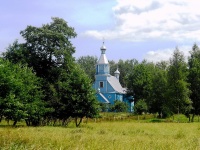- Home
- →
- Attractions
- →
- church of the Assumption in Lavrishevo
church of the Assumption in Lavrishevo
Lavrishev Assumption Church is a unique monument of spiritual and architectural heritage located in the village of Lavrishevo, Grodno Region. Today, it is the only surviving element of what was once a large Orthodox monastic complex and a significant spiritual center of the region.
History
After the destruction of the ancient Lavrishev Monastery, an Orthodox men’s monastery arose in its place in the 16th century. Its foundation consisted of a church and a brotherhood building, constructed around 1550. However, by 1650, the buildings had fallen into decline, and only the cellars—for storing food and relics—remained from the original church. During the partitions of the Polish-Lithuanian Commonwealth in the late 18th century, due to a lack of Orthodox churches in the Minsk and Grodno provinces, active construction began. By 1776, the Lavrishevo Monastery was rebuilt: a church, library, brotherhood building, and bell tower. Over time, the brotherhood building collapsed, and by 1836 the monastery was officially closed. The church, however, has survived through all the upheavals and remains standing to this day.
Architecture
The current Lavrishev Church building is an example of simple yet expressive monastic architecture of the late 18th century, a sample of traditional wooden craftsmanship. Its value lies in the fact that it has not undergone significant reconstruction. The church was never heated, which protected it from damaging humidity and temperature fluctuations. Historical elements have been preserved as well: traces of the monastery fence, a memorial sign to Elisha of Lavrishevo, and remnants of old utility buildings.
Excursions
You can explore this historical site more closely as part of a private tour, which we can organize upon request and combine with visits to other attractions in the region. A tour from Minsk to the Lavrishev Assumption Church is suitable for both pilgrims and lovers of architectural tourism. Stories of the parishioners' resilience—who prevented the church from being looted in the postwar years—and insights into monastic life during the Russian Empire make this excursion especially enriching and profound.

